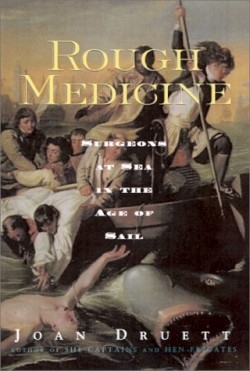Rough Medicine
Surgeons at Sea in the Age of Sail
“If a young doctor wished to see the world and study nature while he saved the money to set up in a private practice, life on a South Seaman could have seemed quite inviting,” Druett informs the reader. Still, the actuality of spending two years or longer on a whaling ship included boredom, living at close quarters, and a restricted diet. Druett relies on the journals of ten doctors from England and one from America to gain an accurate picture of a doctor’s life at sea in the mid-1800s.
Druett calls John Woodall “the Father of Sea Surgery,” for his influential book, The Surgions (sic) Mate (1617). While this book helped provide a standard text for the sea surgeon, many medical practices may have done more harm than good. Syphilis was treated with poisonous mercury, and bloodletting was common practice. Druett also provides a detailed account of the items necessary to supply a doctor’s medical chest for a sea journey.
Doctors held less social standing aboard a ship than the second or even third mates. Because English law required a doctor to be onboard a whaling vessel, the captain often resented his presence. The doctor needed to be paid, and when no one required medical treatment, he seemed to be an idle hand. Many captains invented duties for the doctor, such as bookkeeping or stocking the larder. Other doctors, such as Dr. John Coulter, helped with chasing and harpooning whales.
Perhaps the most dangerous disease that a doctor had to treat was scurvy. The initial symptoms-tiredness, depression, and purple spots-progressed to more ghastly ones. “Because vitamin C is necessary for the body to produce collagen, which glues scar tissue together, wounds that had been healed for years opened up, and fractured bones that had knitted broke apart.” This danger became exacerbated when whales were plentiful and the captain was reluctant to return to port. Miraculously, once fresh vegetables had been procured, men who had been near death recovered rapidly.
Druett sketches an engaging portrait of a doctor’s life at sea in the nineteenth century. These doctors required training, just like today’s doctors (though less of it), and followed the medical beliefs of their day. While the treatments they prescribed and operations they administered may have been less than perfect, many believed that having a skilled doctor aboard was better than receiving treatment from a layman. Rough Medicine provides insight into the conditions under which these men attempted to practice medicine, and an understanding of their day-to-day lives. Druett has also written two other books-She Captains: Heroines and Hellions of the Sea and Hen Frigates: Wives of Merchant Captains Under Sail-on the seafaring life.
Reviewed by
Ronald D. Lankford, Jr.
Disclosure: This article is not an endorsement, but a review. The publisher of this book provided free copies of the book to have their book reviewed by a professional reviewer. No fee was paid by the publisher for this review. Foreword Reviews only recommends books that we love. Foreword Magazine, Inc. is disclosing this in accordance with the Federal Trade Commission’s 16 CFR, Part 255.

